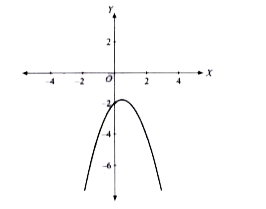Complete Solutions to TEST YOURSELF (Multiple Choice Questions) of chapter QUADRATIC EQUATIONS of Class 10 book with complete answers and questions
| Class 10 | MATHS |
| Chapter | QUADRATIC EQUATIONS |
| CENGAGE | TEST YOURSELF (Multiple Choice Questions) |
| Number Of Questions | 22 |
| Academic Year | 2023-24 |
Sum of roots of the equation `4^(x)-3(2^(x+3))+128=0`, is
View SolutionIf `alpha and beta` are the zeros of the polynomial `f(x)=x^2-5x+k` such that `alpha-beta=1,` find the value of `k`.
01:57View SolutionIf `p(x)=ax^(2)+bx+c` and `Q(x)=-ax^(2)+dx+c`, where `ac!=0`, then `P(x)xxQ(x)=0` has at least
View SolutionIf roots of the equation `(q-r)x^(2)+(r-p)x+(p-q)=0` are equal, then p,q and r are in
View SolutionIf `3p^(2)=5p+2` and `3q^(2)=5q+2` where `p!=q`, then pq is equal to
View SolutionIf `alpha` and `beta` are the roots of the quadratic equation `x^(2)+bx-c=0`, then the equation whose roots are b and c, is
View SolutionLet `p,q in {1,2,3,4}`. The number of equations of the form `px^(2)+qx+1=0` having real roots, is
View SolutionFind the number of rational roots of the equation `(x+2)(x+3)(x+8)(x+12)=4x^(2)`
View SolutionSolutions of the equation `(6-x)^(4)+(8^(4)-x)^(4)=16` are
View SolutionSolution of the equation
`sqrt(2x^(2)+5x-2)-sqrt(2x^(2)+5x-9)=1` areView SolutionSolutions of the equation `64xx9^(x)-84xx12^(x)+27xx16^(x)=0` are
View SolutionLet `alpha,beta` be the roots of the equation `x^(2)-x+p=0`
and `gamma,delta` be the roots of the equation `x^(2)-4x+9=0`.
If `alpha,beta,gamma` `delta` are in GP then the integral value of p and q, respectively, areView SolutionIf `alpha,beta` are the roots of the equation `x^(2)-3x+5=0`
and `gamma,delta` are the roots of the equation `x^(2)+5x-3=0`,
then the equation whose roots are `alpha gamma+beta delta` and `alphadelta+betagamma`, isView SolutionIf `cos^(4)theta+p,sin^(4)theta+p` are the roots at the equation `x^(2)+a(2x+1)=0` and `cos^(2)theta+q,sin^(2)theta+q` are the roots of the equation `x^(2)+4x+2=0` then a is equal to
View SolutionIf `alpha` and `beta` roots of the equation `x^(2)-p(x+1)-c=0` hen `(alpha^(2)+2alpha+1)/(alpha^(2)+2alpha+c)+(beta^(2)+2beta+1)/(beta^(2)+2beta+c)=`
View SolutionThe quadratic equation, product of whose roots `x_(1)` and `x_(2)` is equal to 4 and are related as
`(x_(1))/(x_(1)-1)+(x_(2))/(x_(2)-1)=2`, isView SolutionIf one root of the equation `x^(2)-dx+12=0` is even prime, while `x^(2)+dx+mu=0` has equal roots then `mu` is
View SolutionThe graph of a quadratic polynomial `y=ax^(2)+bx+c,a,b,c in R` is as shown.

Which one of the is NOT correct ?04:05View SolutionIf `x+1/x=5` then `x^(3)-5x^(2)+x+(1)/(x^(3))-(5)/(x^(2))+1/x=`
03:18View SolutionIf `(a^(2)-1)x^(2)+(a-1)x+(a^(2)-4a+3)=0` is an identity in x, then the value of a is/are
02:38View SolutionIf `alpha` and `beta` are the roots of `ax^(2)+bx+c=0`, then which of the following are the roots of the equation `ax^(2)-bx(x-1)+c(x-1)^(2)=0` ?
06:33View SolutionThe equation for `x:3sqrt(2x-1)+3sqrt(x-1)=1` is
View Solution
TEST YOURSELF (Multiple Choice Questions) questions and complete solutions for chapter QUADRATIC EQUATIONS of CENGAGE of Class 10
